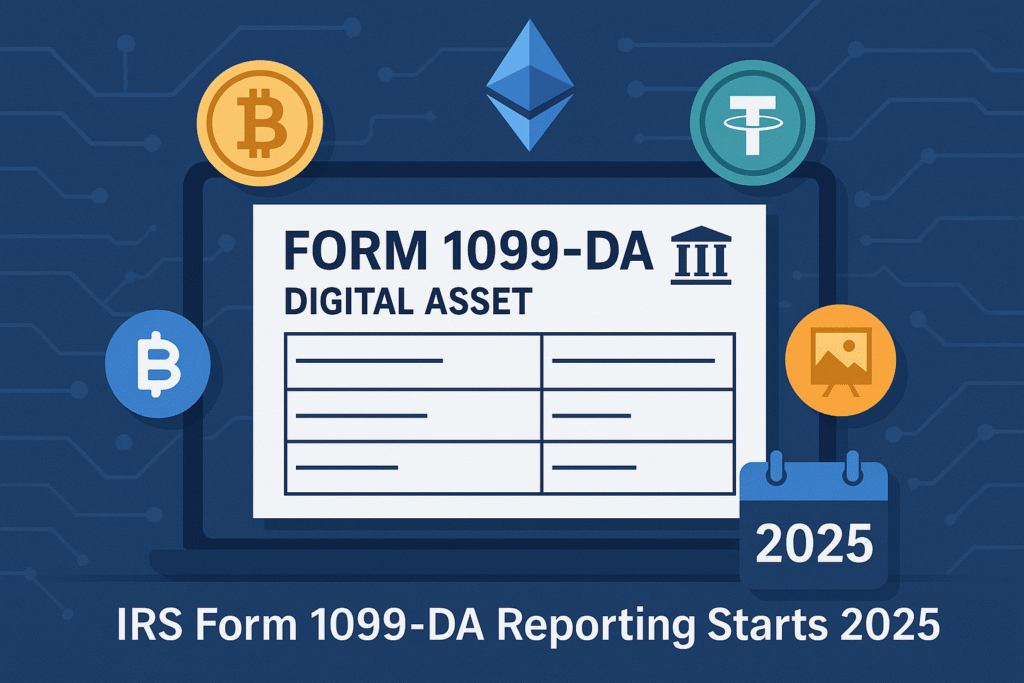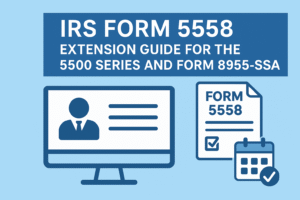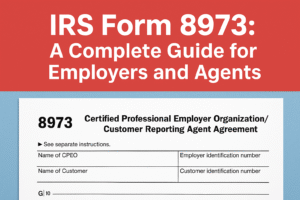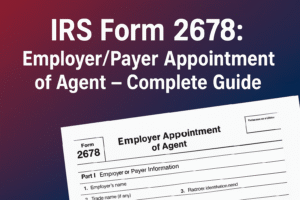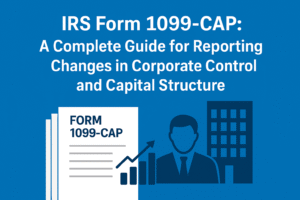As the digital asset economy continues to expand, the IRS is tightening its compliance framework to ensure proper tax reporting and transparency. One of the key developments for tax year 2025 is the introduction of Form 1099-DA, a new informational return used to report digital asset transactions to the IRS.
Whether you’re a broker, investor, or crypto exchange operator, understanding how Form 1099-DA works is essential to ensure regulatory compliance and avoid penalties.
What Is Form 1099-DA?
Form 1099-DA (Digital Assets) is a new tax reporting form introduced by the IRS to capture information related to digital asset transactions. It is similar in purpose to Form 1099-B, which reports proceeds from broker and barter exchanges, but tailored specifically for cryptocurrency, stablecoins, non-fungible tokens (NFTs), and other digital assets.
It will be used by brokers and certain digital asset middlemen to report:
- Gross proceeds from digital asset sales or exchanges
- Cost basis (starting in 2026 for covered securities)
- Customer and transaction details
Why Was Form 1099-DA Introduced?
Form 1099-DA was introduced to improve tax compliance in the rapidly expanding digital asset market, where many transactions involving cryptocurrencies and NFTs were going unreported. It was created under the Infrastructure Investment and Jobs Act (IIJA) of 2021, which amended the tax code to classify digital asset platforms and intermediaries as “brokers.” This law requires them to report gross proceeds and eventually cost basis on digital asset sales to the IRS. The goal is to ensure transparency, traceability, and fair taxation, much like how stock and bond transactions are already reported using Form 1099-B.
Types of Digital Assets
The IRS defines digital assets broadly to include:
- Cryptocurrencies (e.g., Bitcoin, Ethereum)
- Stablecoins (e.g., USDC, DAI, Tether)
- Non-Fungible Tokens (NFTs)
- Wrapped tokens (e.g., WBTC)
- Utility tokens (used for access to specific applications or services)
- Governance tokens (granting voting rights in decentralized protocols)
Real-Time Example:
If a user sells 2 ETH on Coinbase for $4,000 in 2025, the transaction will be reported on Form 1099-DA by Coinbase (as a broker), showing the gross proceeds and—if available—the cost basis.
Who Must File Form 1099-DA?
Entities required to file Form 1099-DA include:
- Digital asset brokers
- Crypto exchanges (centralized and decentralized, if they facilitate transactions)
- Wallet providers offering transaction execution services
- Payment processors and kiosks that handle crypto payments
- Any platform acting as a digital asset middleman
Who Is a Broker & Digital Asset Middleman?
Broker:
Under IRS rules, a broker includes any person (business or platform) that is responsible for regularly providing a platform to facilitate sales or exchanges of digital assets.
Digital Asset Middleman:
This includes anyone who facilitates the transfer of digital assets for consideration. It could include:
- Crypto trading platforms
- Decentralized exchanges (DEXs)
- NFT marketplaces
- Custodial wallet providers
- Some smart contracts (depending on control level)
1099-DA Filing Mandatory Timeline
| Tax Year | Reporting Requirements |
| 2025 | Mandatory: Gross proceeds reporting Voluntary: Cost basis reporting |
| 2026 & Beyond | Mandatory: Gross proceeds and basis reporting (for covered securities) Voluntary: Basis for noncovered securities |
When Is the Deadline to File 1099-DA?
- To IRS (paper filing): February 28, 2026
- To IRS (electronic filing): March 31, 2026
- To recipient (investor): January 31, 2026
Note: If any of these dates fall on a weekend or holiday, the deadline moves to the next business day.
What Information Is Reported on Form 1099-DA?
Form 1099-DA will report the following:
- Name, address, and TIN of the recipient
- Description of the digital asset
- Date acquired and date sold
- Gross proceeds from the sale
- Cost basis (if known or covered)
- Type of asset (e.g., cryptocurrency, stablecoin, NFT)
- Wallet address and transaction ID
- Whether the transaction was reported on a blockchain
Real-Time Example:
If John sells an NFT for $3,000 that he originally bought for $1,000, the broker (NFT platform) will issue a 1099-DA showing:
- Gross proceeds: $3,000
- Cost basis (voluntary in 2025): $1,000
- Asset type: Specified NFT
What’s Not Reported on Form 1099-DA?
- Transfers between your own wallets (non-sale)
- Buying crypto with fiat currency
- Receiving crypto as a gift
- Mining or staking income (reported on 1099-MISC)
- Airdrops or hard forks (still taxable but reported differently)
How to Complete Form 1099-DA (Line-by-Line Instructions)
While the final form layout is still in draft, here’s a breakdown based on expected fields:
| Box | What to Report |
| 1a | Digital asset identifier (name/symbol) |
| 1b | Wallet address (sender/recipient) |
| 2 | Date of acquisition |
| 3 | Date of sale or exchange |
| 4 | Gross proceeds |
| 5 | Cost or other basis (if covered) |
| 6 | Gain or loss (optional in 2025) |
| 7 | Asset type (e.g., crypto, NFT, stablecoin) |
| 8 | Transaction ID or hash |
| 9 | Indicate if blockchain-verified |
| 10 | Remarks or notes (if applicable) |
What Is the Late Filing Penalty of Form 1099-DA?
Failing to file Form 1099-DA or furnishing it late can result in substantial penalties:
| Days Late | Penalty Per Form |
| ≤30 days late | $60 per form |
| 31-60 days late | $120 per form |
| >60 days late or not filed | $310 per form |
| Intentional disregard | $630+ per form |
The maximum penalty can go up to millions for large businesses.
Who Is Exempt from Form 1099-DA Reporting?
The following are typically exempt:
- Non-broker individuals
- Pure software providers without control over assets
- Validators (unless facilitating asset transfer)
- Non-U.S. brokers (may be subject to different treaties)
Note: IRS definitions are evolving—some decentralized platforms may still be considered brokers.
Frequently Asked Questions (FAQs)
What is Cost Basis Reporting?
Cost basis refers to the original value (purchase price) of an asset, including transaction fees. It’s used to calculate capital gains or losses when sold.
What Is a Covered Security?
A covered security is a digital asset bought after January 1, 2025, for which the broker has both acquisition and sale information. Brokers must report cost basis for these assets starting in 2026.
What Is a Noncovered Security?
Assets acquired before 2025 or those transferred without acquisition data. Brokers are not required to report basis for these, but may do so voluntarily.
What Is a Qualifying Stablecoin?
A qualifying stablecoin is a digital asset pegged to a fiat currency and meets IRS criteria for reporting, such as regular trading and valuation mechanisms. Examples: USDC, USDT, DAI.
What Is a Specified NFT?
A Specified NFT is a non-fungible token designated by the IRS for reporting due to its tradeable nature or investment-like characteristics. Not all NFTs are currently specified.
Final Thoughts
Form 1099-DA represents a monumental shift in how digital assets are regulated in the U.S. With the growing use of cryptocurrencies and digital collectibles, the IRS is tightening oversight to close reporting gaps. For brokers and digital platforms, staying compliant with 1099-DA rules starting in 2025 is not optional—it’s essential.
For investors and taxpayers, understanding what this form reports and what it doesn’t will help you better prepare for tax season and avoid unexpected IRS scrutiny.

